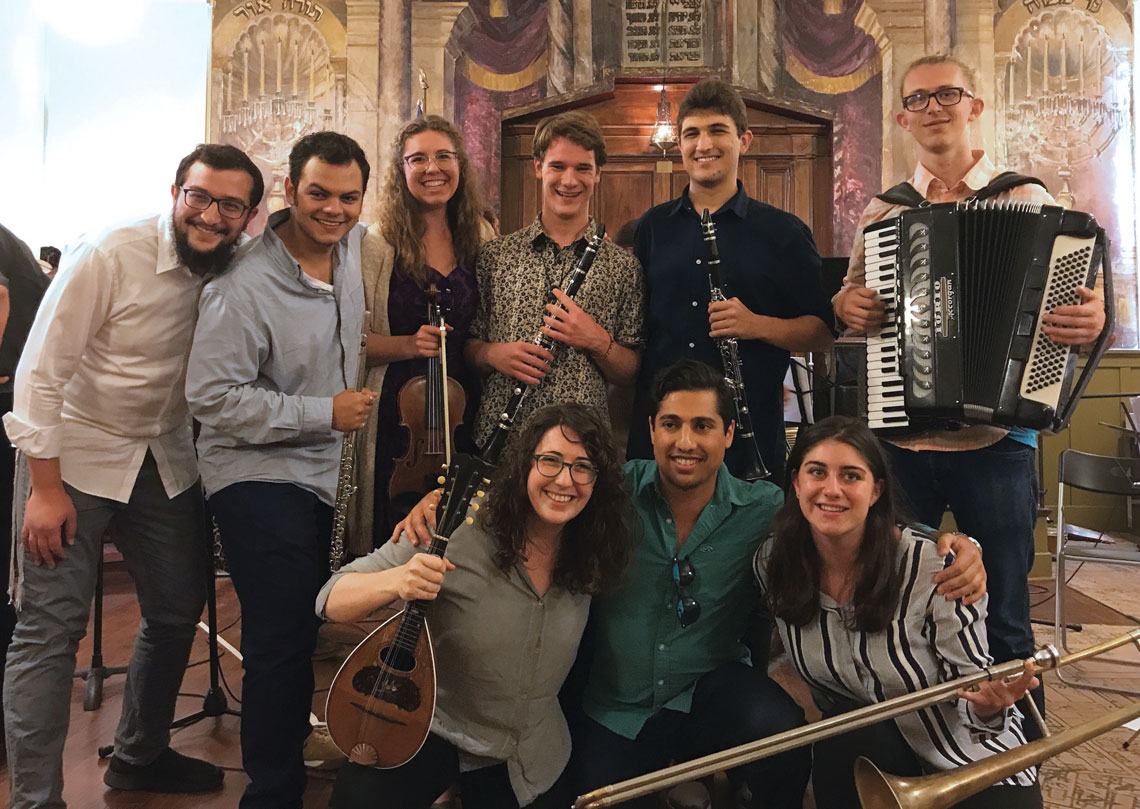 The Klezmer Music Ensemble at UCLA has nine members and is looking to add more. Current members are (top row, from left) Michel Klein, Niccolo Scolieri, Amy Law, Tyler Bailie, Ethan Eshkol and Sam Robertson, and (bottom row, from left) Simone Salmon, Nicholas Nissim Nati and Julia Harnoy. Photo courtesty of Michel Klein
The Klezmer Music Ensemble at UCLA has nine members and is looking to add more. Current members are (top row, from left) Michel Klein, Niccolo Scolieri, Amy Law, Tyler Bailie, Ethan Eshkol and Sam Robertson, and (bottom row, from left) Simone Salmon, Nicholas Nissim Nati and Julia Harnoy. Photo courtesty of Michel Klein From southeastern Europe in the 16th century to … UCLA in 2017?
With its clarinets, accordion, trombone and trumpet, the Klezmer Music Ensemble at UCLA has emerged this year from a class in the Herb Alpert School of Music, Department of Ethnomusicology, and the group is breathing new life into music that originated in southeastern Europe and spread throughout Europe where Jewish populations were present. The UCLA group, which is available for performances, is made up of nine students with a passion for the genre, and fewer than half of them are Jewish.
The UCLA course was started by Mark Kligman, the Mickey Katz Endowed Chair in Jewish Music, and Michel Klein, the ensemble’s leader, and it studies a variety of recordings, from pre-World War II European klezmer to contemporary experimental music. Although it’s a UCLA course, it’s not restricted to university students; anyone who is attracted to klezmer-style music is welcome.
“In addition to seeing it as an offshoot of Mickey Katz’s musical life, which was very much infused with klezmer music, it was important for the sake of Jewish music to have this ensemble available on campus,” Klein said.
The class is scheduled to be offered in the academic year ahead, an encouraging sign for its returning members and leader.
“I think it would be cool for the ensemble to get more performances outside UCLA in the future out in the community,” said Sam Robertson, the group’s accordionist. “Mainly because that means more performance opportunities and we get to interact with more people interested in the music.”
As the group continues into its first full year in the fall 2017, it is expected to perform at least three concerts in the UCLA music library.
“I see really good things,” Klein said. “Last year, we had the ensemble for winter and spring quarter. Next year, the ensemble will be active for the full year, which opens up the door to really exciting possibilities. I’d like to expand our ensemble, including more members with a broader diversity of instruments, as well as to explore the subtler elements of the klezmer genre and style.”
Some students, such as Robertson, have been members of other klezmer groups and were eager to join the ensemble when the class became available.
“I played accordion before the ensemble. I started when I was 11, so I’ve been playing for about nine years now,” Robertson said. “I was originally interested because I liked Greek and Russian music. Now I mostly play Eastern European and Middle Eastern music on [the accordion].”
The ensemble had its first public concert on June 4 at the Breed Street Shul in Boyle Heights as part of the UCLA Alan D. Leve Center for Jewish Studies exhibit “From Brooklyn Ave to Cesar Chavez: Jewish Histories in Multiethnic Boyle Heights.” More than 200 people attended.
Although the neighborhood’s once-thriving Jewish community has long since moved west, the performance brought back the kind of community celebrations that were typical in Boyle Heights, where the temple, built in 1915, once was home to three minyans each morning.
As the ensemble played, a dance circle formed and visitors stomped their feet. The set list included instrumental and lyrical pieces, belted out by Nicholas Nissim Nati, including a traditional horah.
Klein said he was pleased with the performance and the energy that the audience contributed to the group’s music.
“There is a certain element to this music that necessitates audience participation: clapping, singing along, dancing, etc.,” he said. “Klezmer music was never meant to be a formalized music meant for viewing like classical music was. It was primarily music that accompanied the dancing at weddings and other joyous occasions. In a certain sense, the audience stops being an audience and becomes part of the music-making process.”
Ensemble members said they valued how much the audience appreciated them.
“I always enjoy performances like that where we get to play klezmer for audiences that are familiar with the music, like the one in Boyle Heights,” Robertson said. “They know how to respond and dance to it.”





















 More news and opinions than at a Shabbat dinner, right in your inbox.
More news and opinions than at a Shabbat dinner, right in your inbox.